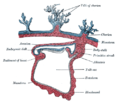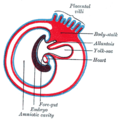トップQs
タイムライン
チャット
視点
尿膜
ウィキペディアから
Remove ads
尿膜 (にょうまく、英: Allantois) は有羊膜類の受胎産物(胚、および胚体外組織からなる)の一部である。胚のガス交換を助け、液状の老廃物を処理する。
機能
この袋状の構造は消化器系および泌尿器系に接続され、血管網で覆われている。尿膜の機能は胚から液状の老廃物を集めるとともに、胚により使用されたガスを交換することである。
爬虫類、鳥類、およびカモノハシ
この構造は初め、爬虫類において窒素性の老廃物を貯蔵するとともに、胚に酸素を供給するため形成された。酸素は卵殻を介して尿膜に吸収される。卵生の哺乳類であるカモノハシ目でも、尿膜の機能は同様である。
有袋類
多くの有袋類において、尿膜は血管を持たないが窒素性の老廃物(アンモニア)を貯蔵するために用いられる。また、多くの有袋類において、尿膜は漿膜と融合しない。例外はバンディクートの尿膜であり、血管網を有するとともに漿膜とも融合する。
胎盤性の哺乳類
Remove ads
追加画像
- Section through the embryo.
- Diagram showing later stage of allantoic development with commencing constriction of the yolk-sac.
- Diagram showing the expansion of amnion and delimitation of the umbilicus.
- Model of human embryo 1.3 mm. long.
- Tail end of human embryo from fifteen to eighteen days old.
- Cloaca of human embryo from twenty-five to twenty-seven days old.
- Tail end of human embryo twenty-five to twenty-nine days old.
- Tail end of human embryo thirty-two to thirty-three days old.
- Opened uterus with cat fetus in midgestation: 1 umbilicus, 2 amnion, 3 allantois, 4 Yolk sac, 5 developing marginal hematoma, 6 maternal part of placenta (endometrium)
- Ultrasound of fetus showing urachus duct from bladder to the umbilicus.
- Ultrasound of fetus showing urachus duct from bladder to the umbilicus.
- Ultrasound of fetus showing urachus duct from bladder to the umbilicus.
- Ultrasound of fetus showing urachus duct from bladder to the umbilicus.
- Ultrasound of fetus showing urachus duct from bladder to the umbilicus.
Remove ads
参考文献
外部リンク
Wikiwand - on
Seamless Wikipedia browsing. On steroids.
Remove ads













